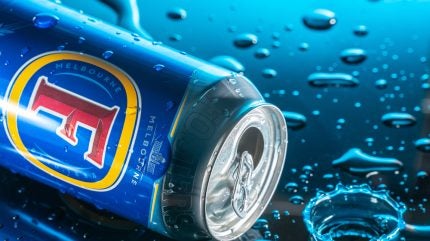
Australia’s beverage sector is moving rapidly towards direct-to-can digital printing, with new systems promising faster turnaround, lower minimums and reduced plastic in the supply chain.
The technology—often called digital can printing or aluminium can printing—is emerging as a practical option for brands seeking on-demand packaging, short runs and more sustainable packaging outcomes.

Discover B2B Marketing That Performs
Combine business intelligence and editorial excellence to reach engaged professionals across 36 leading media platforms.
High-speed direct-to-can printing enters mainstream
Orora has begun producing commercial volumes on “Helio”, a high-speed direct-to-can digital printing line integrated at its Dandenong can plant in Victoria.
Built around Velox IDS-NC 500 technology, the installation is reported to be the first of its kind in the southern hemisphere and the first globally to be fully embedded within a can manufacturing line.
The system can print up to 500 necked aluminium cans per minute and supports full-colour, photorealistic decoration.

US Tariffs are shifting - will you react or anticipate?
Don’t let policy changes catch you off guard. Stay proactive with real-time data and expert analysis.
By GlobalDataThe platform enables 360-degree graphics and offers multiple varnish options, including matte, gloss and high-build textures. It also extends print to the chime and neck—areas usually left undecorated on conventional lines.
By eliminating plates, shrink sleeves and pressure-sensitive labels, Helio targets shorter lead times and lowers the minimum economic order for beverage packaging.
The approach aligns with search trends around “sustainable packaging” and “digital can printing Australia,” as brands seek to remove plastic embellishments and streamline recycling.
Short-run custom cans target rapid campaigns
At the agile end of the market, Melbourne-based Onpack is using a Hinterkopf D240 press to supply short-run, custom aluminium can printing.
The company partners with Rippl, a hydration brand launched in 2023 that supplies still and sparkling water in slim cans for corporate events, retail activations and limited editions.
Onpack’s fully digital workflow—built on Hybrid Cloudflow and CERM MIS—supports rapid version control across multiple stock-keeping units and near-real-time scheduling.
According to the businesses, Onpack can convert blank cans into finished, branded product within 24–48 hours, with no plate or tooling costs. Since launch the partnership has produced more than 300,000 cans, sometimes running up to 70 SKUs in a single cycle.
This model underscores how direct-to-can digital printing can underpin “on-demand packaging” strategies, allowing marketers to execute hyper-targeted or seasonal campaigns without committing to large inventories.
Durable digital cans aim to cut plastic waste
New South Wales firm East Coast Canning + Printing has focused on durability, a key barrier to wider adoption of digital can printing.
After three years of development, the company introduced “BulletProof”, a digitally printed aluminium can designed to withstand tunnel pasteurisation, transport stresses and ice-bucket conditions while maintaining shelf appearance.
The cans are fully recyclable and support premium finishes such as matte, spot-gloss and tactile patterned gloss.
East Coast Canning + Printing estimates its direct-to-can solutions have already prevented more than 50 million units of plastic labelling material from entering the market—a signal of how digital can decoration can complement aluminium’s closed-loop recycling.
Early use cases include craft beer and ready-to-drink products; Yulli’s Brews has employed the format for a Ranch Water release, and interest is building from coffee and low-alcohol wine brands that require pasteurisation-resilient packaging.
What the shift means for beverage brands
The combined activity from Orora, Onpack and East Coast Canning + Printing suggests direct-to-can digital printing is moving from trial to tool in Australia’s beverage packaging.
High-speed lines bring mass-production capability, while short-run systems offer fast, customised campaigns. Durability advances expand where digitally printed cans can be used, including pasteurised beverages and harsher distribution environments.
For marketers, the implications are practical: reduced lead times, lower minimum orders and fewer plastic components to manage in recycling streams.
For operations teams, integrated digital lines and automated workflows promise greater flexibility across SKUs without compromising throughput.
As search demand grows around terms like “digital can printing,” “aluminium can printing,” “beverage packaging” and “sustainable packaging,” the Australian market is positioning direct-to-can as a credible route to faster launches, design experimentation and more circular pack formats.





